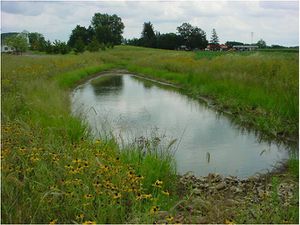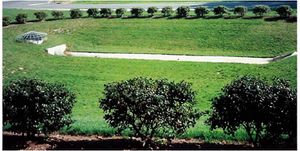
Difference between revisions of "Stormwater ponds"
m |
m |
||
| Line 23: | Line 23: | ||
<!--*[[Supporting material for stormwater ponds]]--> | <!--*[[Supporting material for stormwater ponds]]--> | ||
| − | < | + | <!--A one page [[Fact sheets for stormwater ponds|fact sheet]] for stormwater ponds provides overview information, a short summary of design, construction and maintenance considerations, and information on stormwater volume and pollutant removal.--> |
| − | A one page [[Fact sheets for stormwater ponds|fact sheet]] for stormwater ponds provides overview information, a short summary of design, construction and maintenance considerations, and information on stormwater volume and pollutant removal. | ||
| Line 792: | Line 791: | ||
*Weiss, P.T., J.S. Gulliver and A.J. Erickson, 2005. The Cost and Effectiveness of Stormwater Management Practices: Final Report. University of Minnesota, St. Anthony Falls Hydraulic Laboratory, Minneapolis, Minnesota, 99p. | *Weiss, P.T., J.S. Gulliver and A.J. Erickson, 2005. The Cost and Effectiveness of Stormwater Management Practices: Final Report. University of Minnesota, St. Anthony Falls Hydraulic Laboratory, Minneapolis, Minnesota, 99p. | ||
*Winer, R. National Pollutant Removal Performance Database, 2000.--> | *Winer, R. National Pollutant Removal Performance Database, 2000.--> | ||
| − | |||
| − | |||
Revision as of 19:50, 29 March 2013
Generally speaking, the term “stormwater pond” may refer to any constructed basin that is built for the purpose of capturing and storing stormwater runoff, either temporarily or for an extended period of time, in order to prevent or mitigate downstream water quantity or quality impacts. Several distinct structure types (wet ponds, dry ponds, etc.) are included in this general category, and they are discussed in more detail in the Manual.
The sections in this chapter may be viewed as a single page.
Stormwater ponds articles
- Overview for stormwater ponds
- Types of stormwater ponds
- Design criteria for stormwater ponds
- Construction specifications for stormwater ponds
- Operation and maintenance of stormwater ponds
- Calculating credits for stormwater ponds
- Cost-benefit considerations for stormwater ponds
- References for stormwater ponds

